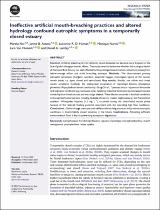 ResearchSpace
ResearchSpace
Ineffective artificial mouth-breaching practices and altered hydrology confound eutrophic symptoms in a temporarily closed estuary
JavaScript is disabled for your browser. Some features of this site may not work without it.
- ResearchSpace
- →
- Research Publications/Outputs
- →
- Journal Articles
- →
- View Item
| dc.contributor.author |
Nel, M

|
|
| dc.contributor.author |
Adams, JB

|
|
| dc.contributor.author |
Human, LRD

|
|
| dc.contributor.author |
Nunes, M

|
|
| dc.contributor.author |
Van Niekerk, Lara

|
|
| dc.contributor.author |
Lemley, DA

|
|
| dc.date.accessioned | 2024-04-12T12:30:27Z | |
| dc.date.available | 2024-04-12T12:30:27Z | |
| dc.date.issued | 2023-12 | |
| dc.identifier.citation | Nel, M., Adams, J., Human, L., Nunes, M., Van Niekerk, L. & Lemley, D. 2023. Ineffective artificial mouth-breaching practices and altered hydrology confound eutrophic symptoms in a temporarily closed estuary. <i>Marine and Freshwater Research, 74(18).</i> http://hdl.handle.net/10204/13661 | en_ZA |
| dc.identifier.issn | 1323-1650 | |
| dc.identifier.issn | 1448-6059 | |
| dc.identifier.uri | https://doi.org/10.1071/MF23053 | |
| dc.identifier.uri | http://hdl.handle.net/10204/13661 | |
| dc.description.abstract | Context: Artificial breaching of intermittently closed estuaries has become more frequent in the face of global-change pressures. Aims: This study aimed to determine whether the ecological health of the Great Brak Estuary has been affected by the prolonged loss of marine connectivity arising from below-average inflow and failed breaching attempts. Methods: We characterised primary eutrophic symptoms (inorganic nutrients, dissolved oxygen, microalgae) typical of the various mouth states, i.e. open, closed and semi-closed. Key results: Initially, low inflow and closed mouth conditions facilitated the widespread occurrence of macroalgal blooms (Cladophora glomerata). Phytoplankton bloom conditions (>20 µg Chl-a L-1) ensued only in response to favourable hydrodynamic conditions (e.g. increased water residency, halocline formation) and increased nutrient availability from fluvial sources and macroalgal dieback. These blooms occurred in brackish conditions and comprised numerous taxa, including Cyclotella atomus var. marina, Cryptomonas sp. and Prorocentrum cordatum. Widespread hypoxia (<2 mg L-1) occurred during the semi-closed mouth phase because of the reduced flushing potential associated with the preceding high flow conditions. Conclusions: Global-change pressures and ineffective breaching practices will promote eutrophic conditions in intermittently closed estuaries in the future. Implications: Allocating sufficient environmental flows is key to preventing ecosystem degradation. | en_US |
| dc.format | Fulltext | en_US |
| dc.language.iso | en | en_US |
| dc.relation.uri | https://www.publish.csiro.au/MF/MF23053 | en_US |
| dc.source | Marine and Freshwater Research, 74(18) | en_US |
| dc.subject | Eutrophication | en_US |
| dc.subject | Harmful algal blooms | en_US |
| dc.subject | Hypoxia | en_US |
| dc.subject | Macroalgae | en_US |
| dc.subject | Microphytobenthos | en_US |
| dc.subject | Mouth management | en_US |
| dc.subject | Phytoplankton | en_US |
| dc.subject | Water quality | en_US |
| dc.title | Ineffective artificial mouth-breaching practices and altered hydrology confound eutrophic symptoms in a temporarily closed estuary | en_US |
| dc.type | Article | en_US |
| dc.description.pages | 1519-1535 | en_US |
| dc.description.note | © 2023 The Author(s), or their employer(s). Published by CSIRO Publishing | en_US |
| dc.description.cluster | Smart Places | en_US |
| dc.description.impactarea | Coastal Systems | en_US |
| dc.identifier.apacitation | Nel, M., Adams, J., Human, L., Nunes, M., Van Niekerk, L., & Lemley, D. (2023). Ineffective artificial mouth-breaching practices and altered hydrology confound eutrophic symptoms in a temporarily closed estuary. <i>Marine and Freshwater Research, 74(18)</i>, http://hdl.handle.net/10204/13661 | en_ZA |
| dc.identifier.chicagocitation | Nel, M, JB Adams, LRD Human, M Nunes, Lara Van Niekerk, and DA Lemley "Ineffective artificial mouth-breaching practices and altered hydrology confound eutrophic symptoms in a temporarily closed estuary." <i>Marine and Freshwater Research, 74(18)</i> (2023) http://hdl.handle.net/10204/13661 | en_ZA |
| dc.identifier.vancouvercitation | Nel M, Adams J, Human L, Nunes M, Van Niekerk L, Lemley D. Ineffective artificial mouth-breaching practices and altered hydrology confound eutrophic symptoms in a temporarily closed estuary. Marine and Freshwater Research, 74(18). 2023; http://hdl.handle.net/10204/13661. | en_ZA |
| dc.identifier.ris | TY - Article AU - Nel, M AU - Adams, JB AU - Human, LRD AU - Nunes, M AU - Van Niekerk, Lara AU - Lemley, DA AB - Context: Artificial breaching of intermittently closed estuaries has become more frequent in the face of global-change pressures. Aims: This study aimed to determine whether the ecological health of the Great Brak Estuary has been affected by the prolonged loss of marine connectivity arising from below-average inflow and failed breaching attempts. Methods: We characterised primary eutrophic symptoms (inorganic nutrients, dissolved oxygen, microalgae) typical of the various mouth states, i.e. open, closed and semi-closed. Key results: Initially, low inflow and closed mouth conditions facilitated the widespread occurrence of macroalgal blooms (Cladophora glomerata). Phytoplankton bloom conditions (>20 µg Chl-a L-1) ensued only in response to favourable hydrodynamic conditions (e.g. increased water residency, halocline formation) and increased nutrient availability from fluvial sources and macroalgal dieback. These blooms occurred in brackish conditions and comprised numerous taxa, including Cyclotella atomus var. marina, Cryptomonas sp. and Prorocentrum cordatum. Widespread hypoxia (<2 mg L-1) occurred during the semi-closed mouth phase because of the reduced flushing potential associated with the preceding high flow conditions. Conclusions: Global-change pressures and ineffective breaching practices will promote eutrophic conditions in intermittently closed estuaries in the future. Implications: Allocating sufficient environmental flows is key to preventing ecosystem degradation. DA - 2023-12 DB - ResearchSpace DP - CSIR J1 - Marine and Freshwater Research, 74(18) KW - Eutrophication KW - Harmful algal blooms KW - Hypoxia KW - Macroalgae KW - Microphytobenthos KW - Mouth management KW - Phytoplankton KW - Water quality LK - https://researchspace.csir.co.za PY - 2023 SM - 1323-1650 SM - 1448-6059 T1 - Ineffective artificial mouth-breaching practices and altered hydrology confound eutrophic symptoms in a temporarily closed estuary TI - Ineffective artificial mouth-breaching practices and altered hydrology confound eutrophic symptoms in a temporarily closed estuary UR - http://hdl.handle.net/10204/13661 ER - | en_ZA |
| dc.identifier.worklist | 27661 | en_US |





